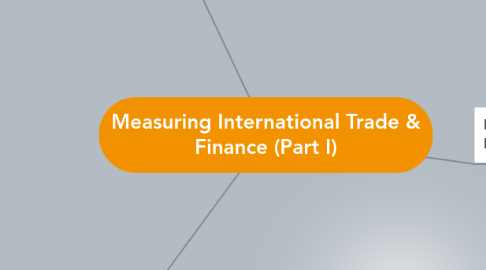
1. Reasons for TRADE
1.1. Supply Reasons
1.1.1. Differences in ability to produce - Different quantities and qualities of productive resources - Affects cost of production
1.1.2. Immobility of Factors of Production - Difficult to move resources internationally - Better to produce foods they can produce easily then trade
1.1.3. Desire to Reap Internal Economies of Scale - Increase production to lower unit cost of production - Take advantage of mass production
1.1.4. Desire to Reap External Economies of Scale - To benefit from trade => Expansion of economy or other industries => lowers cost of production indirectly. (E.g. Increased productivity of labor, improvement in technology...)
1.2. Demand Reasons
1.2.1. Product Differentiation - Provide a variety of goods for consumers - Different demand of goods leading to different prices => Beneficial to trade the surplus
1.2.2. Stage of Economic Development - Lead to different types of imports to supplement domestic production or consumption - Less developed countries => Import consumer goods (Lack productive capacity) - Developing countries => Import capital goods
2. Balance of Payments Disequilibrium
2.1. Causes
2.1.1. Structural Changes
2.1.2. Cyclical Changes
2.1.3. Exchange Rate
2.1.4. External Factors
2.2. BOP Deficit
2.2.1. Effects
2.2.1.1. Short term improvement in material SOL
2.2.1.2. Negative effect of AD & EG
2.2.1.3. Reduces country's gold & foreign exchange reserves
2.2.1.4. Worsen economy in the long run (Jobs, RNY, exchange rate)
2.2.1.5. Result in loans: - Repaid with foreign exchange - Lender may dominate economically/ politically.
2.2.2. Measures to correct
2.2.2.1. Expenditure- reducing policies - Decrease expenditure on imports
2.2.2.2. Expenditure- switching policies - Encourage consumption of locally produced goods ( Tariffs, subsidies, quotas, exchange controls, devaluation ) - Encourage exports (Export incentives)
2.2.2.2.1. Conditions for devaluation to be effective - Marshall-Lerner condition: Sum of PED of imports and exports > 1 (J-curve effect) - PES of exports > 1 - Domestic costs must be low (Ensure low COP) - Exports must not contain large proportion of imported raw materials - No speculation: Foreign investors lose confidence => decrease capital inflow - Trading partners do not implement protectionist measures.
2.2.2.3. Supply side policies - Provide research grants/ subsidies to lower COP - Relax investment controls
2.3. BOP Surplus
2.3.1. Effects
2.3.1.1. Trading partners suffer: May impose protectionist measures
2.3.1.2. Increase foreign exchange reserves => Increase MS => Increase Income => Inflation
2.3.2. Measures to correct
2.3.2.1. Expenditure- switching - Encourage consumption of imports
2.3.2.2. Expenditure- raising - Increase expenditure on imports
3. Measuring Trade: Balance of Payments
3.1. Introduction
3.1.1. Receipts ( Money from abroad) - Credits: Inflow of money, outflow of goods
3.1.2. Payments ( Money paid abroad ) - Debits: Inflow of goods, outflow of money
3.2. Current account
3.2.1. Balance of Trade/ Visible Trade A/c - Records imports and exports of physical goods
3.2.2. Invisible Trade A/c - Records imports and exports of services (E.g. Shipping, transportation and government expenditure...)
3.2.3. Unilateral Transfers - Records gifts and money sent/received, to/from abroad. - Includes gov. aids and grants
3.2.4. Income flows - Includes: Interest from loans, profits from companies abroad, dividends in MNCs.
3.3. Capital and Financial account
3.3.1. Short-term capital flows - Liquid funds/ hot money searching for higher i/r and safety of capital.
3.3.2. Long-term capital flows - Includes FDI (Assets) and Portfolio Investments (Paper assets). - Inflow: Investment in the home country (Credit) - Outflow: Investing overseas (Debit)
3.4. Factors affecting BOP
3.4.1. Income Levels - Affects purchasing power of locals (Imports) - Affects purchasing power of consumers in exporting countries (Exports)
3.4.2. Country's stage of development - Affect types and values of imports
3.4.3. Investment Prospects - Business expectations affects investments
3.4.4. Interest Rate - Affects hot money flow
3.4.5. Changes in prices of imports and exports - Affects BOT, hence BOP - Dependent on price elasticity
3.4.6. Government Policy (E.g. Tax, subsidies...)
